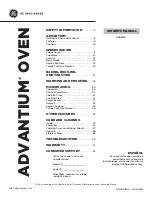
9
5) Stir foods
From outside to center of dish once or twice during cooking, if possible.
6) Turn foods
Foods such as chicken, hamburgers or steaks should be turned over once during cooking.
7) Rearrange foods
Please change the positions of food in half way during cooking such as: from top to bottom and from
the center of the dish to the outside.
8) Allow standing time
After cooking ensure adequate standing time. Remove food from oven and stir if possible. Cover for
standing time which allows the food to finish cooking without overcooking.
9) Check for doneness
Observe the food color and hardness to determine whether the food is cooked. Doneness signs
include:
-Steams throughout food, not just at edge part.
- Joints of Poultry move easily.
- Pork and poultry show no evidence of blood.
- Fish is opaque and flakes easily with a fork.
10) Condensation
It is a normal case of microwave cooking. The humidity and moisture of food will influence the amount
of moisture in the oven. Generally, covered foods will not cause as much condensation as uncovered
foods. Ensure that the ventilation openings are not blocked.
11) Microwave safe plastic wrap
For cooking food with high fat content, do not bring the wrap in contact with the food as it may melt.
12) Microwave safe plastic cookware
Some microwave safe plastic cookware are not suitable for cooking foods with high fat and sugar
content.
CLEANING AND MAINTENANCE
The oven should be cleaned regularly and any food deposits removed.
Suggest you perform below steps after every time use.
Never use hard detergent, gasoline, abrasive powder or metal brush to clean any part of the appliance.
Clean the oven at regular intervals
Disconnect the power supply cord before cleaning. And if possible leave the door open to inactivate
the oven during cleaning.
Exterior:
The outside may be cleaned wipe with a soft and damp cloth. Avoid the use of harsh abrasive cleaners.
Door:
Wipe the door and window on both sides, the door seals and adjacent parts frequently with a damp
cloth to remove any spills or spatters. Do not use abrasive cleaners.
Control panel:
Care should be taken in cleaning the control panel. Wipe the panel with a cloth dampened slightly. Do
not scrub or use any sort of chemical cleaners.
Interior walls:
To clean the interior surfaces, wipe with a soft and damp cloth for hygienic reasons. After use wipe the
waveguide cover in the oven with a soft damp cloth to remove any food splashed. Buildup splashes
may overheat and begin to smoke or catch fire. Do not remove the waveguide cover. Do not use a
commercial oven cleaner, abrasive or harsh cleaners and scouring pads on any part of your microwave
oven. Never spray oven cleaners directly onto any part of your oven.
Turntable/ Rotating ring/Rotating axis





























